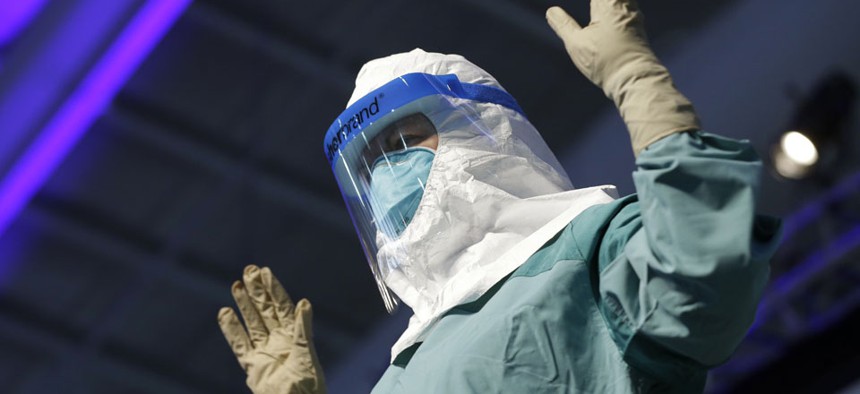The CDC Is Not Messing Around With Its New Rules for Protective Ebola Gear
The agency has a new, extensive process for donning protective wear in U.S. hospitals.
Federal health officials have given a whole new meaning to the phrase "suit up."
The Centers for Disease Control and Prevention released on Monday new, extensive guidelines for hospital workers who treat Ebola patients in the United States. They include detailed procedures for one of the first lines of protection against the deadly virus: protective gear. And, boy, is the CDC not kidding around about how to put that gear on.
The latest guidelines include a 12-step method for donning personal protective gear (and a 21-step process for taking it all off). Another version of the process, which involves different headgear, is 14 steps. Both procedures are much more complicated than the health agency's earlier recommendations for protective gear, which can be found here. That version included just four steps.
Here's what hospital workers must now do every time they come in contact with Ebola patients. The end goal: no exposed skin or hair by the last step.
-
Stand under the watch of a "trained observer," who confirms each step through a written checklist.
-
Remove regular clothes and change into surgical scrubs and plastic or rubber footwear. No jewelry or watches.
-
Make sure you have all the protective gear supplies handy for this process, and check the size of the protective suit.
-
Wash and dry your hands.
-
Put on the first pair of gloves.
-
Place single-use, disposable waterproof covers over shoes.
-
Put on the protective gown, and make sure the cuffs of your gloves are tucked under the sleeves of the gown.
-
Put on a second pair of gloves with extended cuffs, and pull them over the sleeves of the gown.
-
Don an air-purifying respirator with a full face-shield, helmet, or headpiece.
-
Put on a full-body apron for another layer of protection against exposure to patients' bodily fluids.
-
Take a beat. Are you comfortable, and can you raise your arms, bend at the waist, and generally move around without exposing any parts of the body?
- Disinfect the outer layer of gloves with an alcohol-based solution. Wait for them to dry, and then go see your patient.
Nurses' unions across the country have called for greater training and preparation to treat Ebola patients since two Dallas hospital nurses became infected while caring for Thomas Eric Duncan, a Liberian man who died of the disease less than two weeks ago. With these new comprehensive, protective-gear guidelines, CDC officials are not taking any chances.
NEXT STORY: CDC To Award $1.8 Million to Fight Ebola




